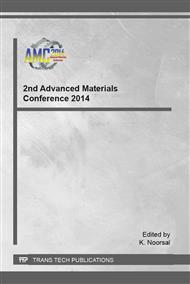p.295
p.300
p.305
p.310
p.314
p.319
p.324
p.329
p.334
Assessing the Physical Properties of Cobalt Chromium Molybdenum (CoCrMo) Foams with Different Composition
Abstract:
Replication or slurry dipping is a simple and popular method of producing porous and interconnected foams using a metallic slurry. The advantage of the network-like metal foams is it exhibits a natural bone-like structure which enables ingrowth of bone cells and blood vessels. The aim of the present study was to investigate the physical properties of Cobalt Chromium Molybdenum (CoCrMo) foams after sintering process using vacuum furnace. The CoCrMo slurry was prepared by using different composition of CoCrMo powder which was 50wt%, 55wt%, 60wt%, 65wt% and 70wt%. The CoCrMo slurry was produced by mixing CoCrMo powder with Polyethylene Glycol (PEG), Carboxyl Methyl Cellulose (CMC) and distilled water. Then, polymeric foam template was impregnated in CoCrMo slurry and dried at room temperature. Sintering was carried out in a high temperature vacuum furnace at 1300°C. The CoCrMo foam was characterized by using a Scanning Electron Microscopy (SEM) analysis. The physical properties of CoCrMo foam was analyzed by porosity and bulk density test that was Archimedes method. From the study it was expected that the composition of metallic slurry play important roles to produce a CoCrMo foam. The best composition that obtained in this experiment was 70wt%. The porosity and density value for 70wt% of composition were 20.3% and 2.63g/cm3. The higher composition of metallic slurry will decrease the density and will increase the porosity.
Info:
Periodical:
Pages:
314-318
Citation:
Online since:
January 2016
Authors:
Keywords:
Price:
Сopyright:
© 2016 Trans Tech Publications Ltd. All Rights Reserved
Share:
Citation:


